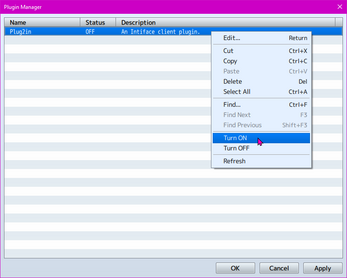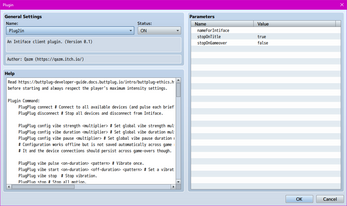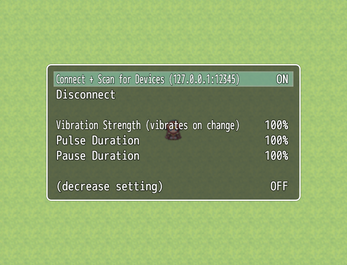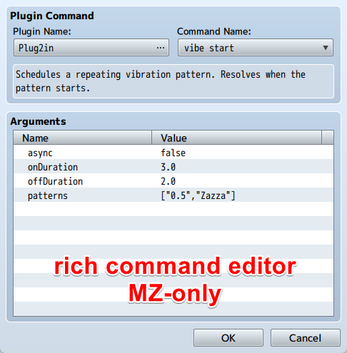Plug₂in for RPG Maker MV and MZ
A downloadable plug₂in
This is an easy-to use pattern rumble plugin for RPG Maker MV and MZ.
Now completely rewritten in 0.2 for easier maintenance, with more powerful API and including a built-in Options sub-menu to deal with connection and configuration.
There is also now a convenient online Pattern Composer (which should be installable using the itch.io desktop app).
The base price is still free, but please consider leaving a tip if you use this commercally. It was a lot of work.
The plugin works both in standalone games and web deployments.
It works with the stock version of NW.js in MZ (MV: update it) and instead uses Intiface to connect to Xbox 360 style gamepads (Windows only) as well as a wide variety of vibrating and oscillating sex toys (cross-platform).
Read https://buttplug-developer-guide.docs.buttplug.io/intro/buttplug-ethics.html before starting and always respect the player's maximum intensity settings.
The https://intiface.com/ server must be running on port 12345 to connect. When running in the browser, connections to localhost must be allowed.
The minified/binary files in the archive (in older versions) are verbatim from buttplug - npm (npmjs.com) (version 1.0.17), from the dist/web/ folder, and you can replace them with fresh copies if necessary.
Generally speaking, you only need to extract the archive into your plugins folder though.
A note on compatibility:
I had to add delete process.versions.node; for this to work, as https://github.com/rust-random/getrandom doesn't work correctly in NW.js without the Node Crypto module otherwise. (This removes the package versions table entry for Node.js at runtime, to make getrandom not detect it and use the browser API instead.)
If this plugin causes issues with others, it's most likely because of that.The latest version doesn't need this workaround!
Tested with RPG Maker MV Version 1.6.2.
Tested with RPG Maker MZ Version 1.7.0.
Parameters:
Name for Intiface:
The application name to show in the intiface server GUI.
(Defaults to game title.)
Stop on Title/Stop on Game Over:
Automatically stop all activity when reaching certain screens.
End on Title/End on Game Over:
Automatically end all activity when reaching certain screens, without cancelling the current pattern queue. These default to true.
Options Entry:
Adds an additional entry to the Options menu for configuration (see screenshots).
The texts of this entry and the menu are also configurable.
Plugin Command:
PlugPlug connect
# Connect to all available devices (and pulse each briefly to confirm).
PlugPlug disconnect
# Stop all devices and disconnect from Intiface.
PlugPlug config
# Opens the interactive configuration screen (pauses gameplay).
PlugPlug config vibe strength <multiplier>
# Set global vibe strength multiplier. 0.0 - 26.0. Default: 1.0
PlugPlug config vibe duration <multiplier>
# Set global vibe duration multiplier: 0.0 - infinity. Default: 1.0
PlugPlug config vibe pause <multiplier>
# Set global vibe pause duration multiplier: 0.0 - infinity. Default: 1.0
PlugPlug config osci strength <multiplier>
# Set global oscillation speed multiplier. 0.0 - 26.0. Default: 1.0
PlugPlug config osci duration <multiplier>
# Set global oscillation duration multiplier: 0.0 - infinity. Default: 1.0
PlugPlug config osci pause <multiplier>
# Set global oscillation pause duration multiplier: 0.0 - infinity. Default: 1.0
PlugPlug config linear min <multiplier> # Set global linear min retraction. 0.0 - 1.0. Default: 0.0
PlugPlug config linear max <multiplier> # Set global linear max retraction. 0.0 - 1.0. Default: 1.0
PlugPlug config linear duration <multiplier> # Set global linear pattern duration multiplier: 0.0 - infinity. Default: 1.0
PlugPlug config linear moveDuration <multiplier> # Set global linear move duration multiplier: 0.0 - infinity. Default: 1.03
PlugPlug config linear pause <multiplier> # Set global linear pause duration multiplier: 0.0 - infinity. Default: 1.0
Configuration works offline and is now saved automatically, if you use the plugin command API or when changed through the included options screen. Use ConfigManager.save(); after changing them from JavaScript.
Vibration commands now use a queue and block until reached or completed.
The queues for vibration and oscillation run independently in parallel.
PlugPlug vibe pulse <on-duration> <off-duration> <pattern>
# Vibrate once, then pause as specified. Now resumes the repeated pattern afterwards!
PlugPlug vibe start <on-duration> <off-duration> <pattern>
# Set a vibration pattern to repeat until told otherwise.
PlugPlug vibe start requireN <required-count> <off-duration> <pattern>
# Like "start", but will repeat <required-count> times before continuing to process the queue.
PlugPlug vibe sync
# Wait for the current vibration queue to catch up.
PlugPlug vibe end
# End vibration after the current queue.
PlugPlug osci pulse <on-duration> <off-duration> <pattern>
# Oscillate once, then pause as specified. Now resumes the repeated pattern afterwards!
PlugPlug osci start <on-duration> <off-duration> <pattern>
# Set an oscillation pattern to repeat until told otherwise.
PlugPlug osci start requireN <required-count> <off-duration> <pattern>
# Like "start", but will repeat <required-count> times before continuing to process the queue.
PlugPlug osci sync
# Wait for the current oscillation queue to catch up.
PlugPlug osci end
# End oscillation after the current queue.
PlugPlug linear pulse <on-duration> <off-duration> <pattern> # Move linearly once, then pause as specified.
PlugPlug linear start <on-duration> <off-duration> <pattern> # Set a linear pattern to repeat until told otherwise.
PlugPlug linear start requireN <required-count> <off-duration> <pattern> # Like "start", but will repeat <required-count> times before continuing to process the queue.
PlugPlug linear sync # Wait for the current linear queue to catch up.
PlugPlug linear end # End linear movement after the current queue.
PlugPlug end
# Independently end vibration and oscillation cleanly after the current queue.
PlugPlug stop
# Stop all motion imediately.
PlugPlug async .../PlugPlug sync
# Commands can be prefixed with "async" to not block. You can use "PlugPlug sync" to only wait for the current queues without doing anything else.
Many commands can be suffixed with "now" to cancel the existing queue and active pattern immediately. See the plugin help text for more information.
About Parameters:
<multiplier>
# A decimal number, scalar and unit-less.
<on-duration>
# The playback duration of the pattern, in seconds.
<off-duration>
# The pause between patterns.
<pattern>
# A pattern definition.
<required-count>
# An integer.
There are two possible types of patterns:
- Constant strength (decimal numbers from 0 to 1), for example 0.9
- More complex patterns defined using the letters A through Z (case-insensitive) as well as the . character. 'A' will use the lowest possible non-zero intensity, 'Z' will use the maximum intensity (1.0) and '.' turns off vibration.
A single pattern is applied to all vibration features at once. Otherwise, linear interpolation is used to distribute the patterns across the device, and the strongest influence at each feature "wins".
Examples:
PlugPlug vibe start 0.3 0 0.5
# Constant half intensity.
PlugPlug vibe pulse 1 0 0.8 0
# 1-second pulse with constant 80% intensity,
# concenctrated on the first motor.
PlugPlug vibe start 2.5 0 ZZZ...ZZ....ZZZ...
# Strong pulsed vibration.
PlugPlug vibe start 5 0 Vbvbvbvbvb..
# Alternating strong and weak vibration, with a pause at the end.
PlugPlug vibe pulse 10 0 mm...mm
# Two slow medium strength vibrations, with a pause.
PlugPlug vibe start 1 2 rrrrrrrr
# Relatively strong vibration,
# but it is not recommended to unnecessarily repeat the pattern.
PlugPlug vibe start 3.0 0 X.X.X.X.X. Y.Y.Y.Y.
# Two patterns in parallel, with mismatched timings.
# (The total duration will be the same.)
PlugPlug vibe pulse 0.5 0 0 abfjmpsvyz
# A curved ramp pattern,
# concentrated on the last motor.
Oscillators and vibrators behave differently in response to input changes! In most cases, it's necessary to test with and fine-tune both separately for each scene!
Note that Intiface now supports customising the range of output values, so usually you should still make use of the full range even if your test device doesn't behave well at low intensities.
The durations likely won't be entirely accurate and timings may drift a bit, as I tried to make sure the game keeps running no matter what.
It's now easier to use multiple patterns/multiple motors: Patterns are automatically interpolated across devices with differing feature count! Where a device has mixed features (like oscillators that also vibrate), the interpolation happens over each group separately since buttplug can automatically split the features.
JS API:
All commands are available through the global `PlugPlug` object.
Just concatenate the command identifiers and pass all parameters in parentheses.
For example:
`PlugPlug.config.vibe.strength(0.8);`
# Set global vibe strength multiplier.
`PlugPlug.connect();`
# Connect to all devices.
`PlugPlug.vibe.start(3, 2, 0.2, 'Vb.vb.vb.vb.vb.');`
# Play back the patterns 0.2 and `Vb.vb.vb.vb.vb.`
# focused on the first and last features of each device,
# stretched over three seconds,
# then pause for two seconds. Repeat indefinitely.
Blocking commands return promises, which means you can wait on their completion from JavaScript.
What about RPG Maker MZ?
There are plugin command declarations for RPG Maker MZ.
What about (linear, rotation…)?
While it would be easy to add additional commands for those interactions, as they are already supported by Intiface, I don't have any test devices for those features.
I'm not comfortable with releasing software that controls mechanical actuators without testing it thoroughly.
How to make a configuration menu?
A configuration menu for players is now included! Please direct them to the Options menu, which will have an additional entry by default when using this plug₂in, or use the PlugPlug config command to show this screen directly.
You can modify this menu by adjusting the global Scene_PlugPlugOptions and Window_PlugPlugOptions classes, or replace it entirely by hooking PlugPlug config and/or proving your own Options menu entry.
Known Issues
Lovense Solace Pro appears to ignore oscillation commands with intensity That was likely my fault and it's fixed in 0.3!0, which causes it to not stop outside of the PlugPlug stop command which immediately halts all features at once.
| Status | Released |
| Category | Assets |
| Rating | Rated 5.0 out of 5 stars (1 total ratings) |
| Author | Qazm |
| Made with | RPG Maker |
| Tags | buttplug, intiface, plugin, RPG Maker, RPG Maker MV, RPG Maker MZ, rpgmv, rpgmz |
| Code license | MIT License |
| Average session | A few seconds |
| Inputs | Xbox controller |
Download
Install instructions
Extract the plugin archive's contents into the plugins folder in your project folder (where Game.rpgproject is located). Add only Plug2in as plugin in RPG Maker!
To more easily adjust the source code, you can additionally use the plugin-source archive. This archive is missing the redistributed files from the buttplug package, but should otherwise function using an npm+TypeScript workflow.
Development log
- Linear support and important bug fix (0.3.0)40 days ago
- Oscillation support (0.2.6)Jun 03, 2024
- Small fix (0.2.5)May 29, 2024
- Windows fix and small MV parameter confusion fix (0.2.4)Dec 30, 2023
- RPG Maker MZ is now supported by Plug2in (0.2.3)!Sep 27, 2023
- 0.2.2 Update (small fixes + new feature)Dec 20, 2022
- 0.2 Update (major rewrite)!Dec 18, 2022




Comments
Log in with itch.io to leave a comment.
I.... Have....
AN IDEA!!!!!
(Setting the vibrations at the highest level if possible every time a party member gets hit.)
A very crude implementation:
You could make it vary by damage dealt or, by looking at
this.resultorGame_Action.prototype.apply, take various other damage properties into account.I just recently discovered this plugin, as an h-game dev, I'm interested, but have questions since I don't own any lovense devices. Can this simulate the player giving a blowjob or is it just the other way around? I look at the catalogue and I don't see anything that looks capable of doing this.
I think someone wired up a dildo to act as input device before, but that’s not what this library is concerned with. Pretty sure Buttplug (the library by qDot that this wraps) only does output.
I’m currently working on adapting support for “linear” features which includes advanced strokers and also fucking machines. The latter may be what you’re looking for if you want to move a dildo back and forth, but they’re usually large pieces of furniture and quite expensive.
Hello,
Thanks again for making this plug in compatible with MZ. I was working on my game and found that Plug2In has a minor incompatibility issue with the Visustella MZ options core plug in. The conflict was related to how it was drawing a rectangle for the Plug2In options menu. I was able to modify the function to make it compatible. I would be happy to send the modified code to you for testing or for a future version update. If you would like it, how should I send it to you?
Thanks,
KG
You can just put the modified function in the comments here, ideally in a markdown code block.
I may not get around to updating this entirely quickly, and this way anyone else can use it too until then. (I’ll add a reply if/when I integrate it directly.)
// Added function to help with Options Core MZ compatability: createOptionsWindow() { // Ensure _optionsWindow is initialized this._optionsWindow = this._optionsWindow || new Window_PlugPlugOptions(this.optionsWindowRect()); this._optionsWindow.setHandler('cancel', () => this.popScene()); this.addWindow(this._optionsWindow); } // Modified original function here for Options Core MZ compatability: optionsWindowRect() { if (typeof Scene_Options.prototype.optionsWindowRect === "function") { try { const rect = Scene_Options.prototype.optionsWindowRect.call(this); // Ensure the rect object has valid width and height properties if (rect && typeof rect.width === "number" && typeof rect.height === "number") { return rect; } } catch (error) { console.warn("Failed to call optionsWindowRect from VisuMZ_1_OptionsCore:", error); } } // Fallback rectangle if the above fails return new Rectangle(0, 0, Graphics.boxWidth, Graphics.boxHeight - 100); }If you see 0.2.7 in the version history: No, you don’t.
(It’s a broken release, I tried to fix a potential issue I noticed, but it didn’t work correctly.)
Hello!
Would it be possible to get your discord contact? :)
I would have some questions regarding your plugin as I would like to use it in my games :)
I would appreciate it if you could help me!
Hey! Sure, I’m just @qazm on there. I may respond with a delay sometimes, but generally within a day.
(For anyone else reading this: please tell me why you’re contacting me and if I know you from somewhere in the first message. I’m not opposed to DMs from strangers, but the experience may be disappointing for you if you don’t frontload that info.)
Can I give you RMMZ as a gift?
I got it in a sale a while ago, but didn't have the opportunity to make plugins with commands for it until recently, since it's Windows/Mac only.
I can probably do that now, thinking about it. I'll look into updating this plugin to make it easier to use in MZ.
Aaand there's RMMZ support now. Enjoy!
Hey can you please help me? I can't seem to get it working. The Lovense plug is connected to Intiface and working over their white usb dongle. Vibrations are working from Intiface, its tutorial, and the Plug2in Pattern Composer; but not RPG Maker MV. I've tried a brand new project export with only the plugin and its companion files in the plugin and libs folders. Ran it in Chrome with Wampserver but the intiface vibration and connect + scan stay off. The serverport is 12345, rpgmv version 1.6.2, and sometimes I get a Plugplug not defined error without me having changed anything.
Do you see any other errors in the developer console (which you can open with F12)?
Edit: You don't put anything into the libs folder for this, it all goes into the plugins folder. That's most likely the issue.
Made another new project and only put the files in the plugins folder only, everything works really well now. Thanks a lot for developing the plugin, excellent work!
Glad to hear that 🙂
If you publish your project later, feel free to comment here with a link to it. I'm curious what this plugin gets used for, somewhat regardless of whether that turns out to be my cup of tea or not.
This plugin is awesome!
Just made this.
Glad it's working for you!
I haven't had opportunity to get creator feedback on using this plugin so far, so if there's anything that was tricky or didn't work as expected, I'd love to know. (You can also suggest additional features, but there it depends on demand and how difficult it would be to add it. I made this as fun/experimental coding project originally and would like to keep it in that range.)
Everything seems to work the way it should, although I haven't tried it with a device with multiple vibes.
Just a heads-up: I've updated this plugin with better reliability, a number of API improvements and a custom options menu. (And hopefully no new bugs.)
The API changed a bit from version 0.1, so I don't recommend upgrading it for existing projects, but if you make a new mod in the future please give it a spin and let me know what you think.
The main improvement is that you can now seamlessly transition between patterns and wait for them to complete in linear scene events. There's better multi-motor support too, so all patterns are now automatically retargeted for devices with fewer or more features.
Cool! I've been thinking about implementing it into more games, I just haven't found the time yet xD. But I will definitely report back when I've tried out the new version!